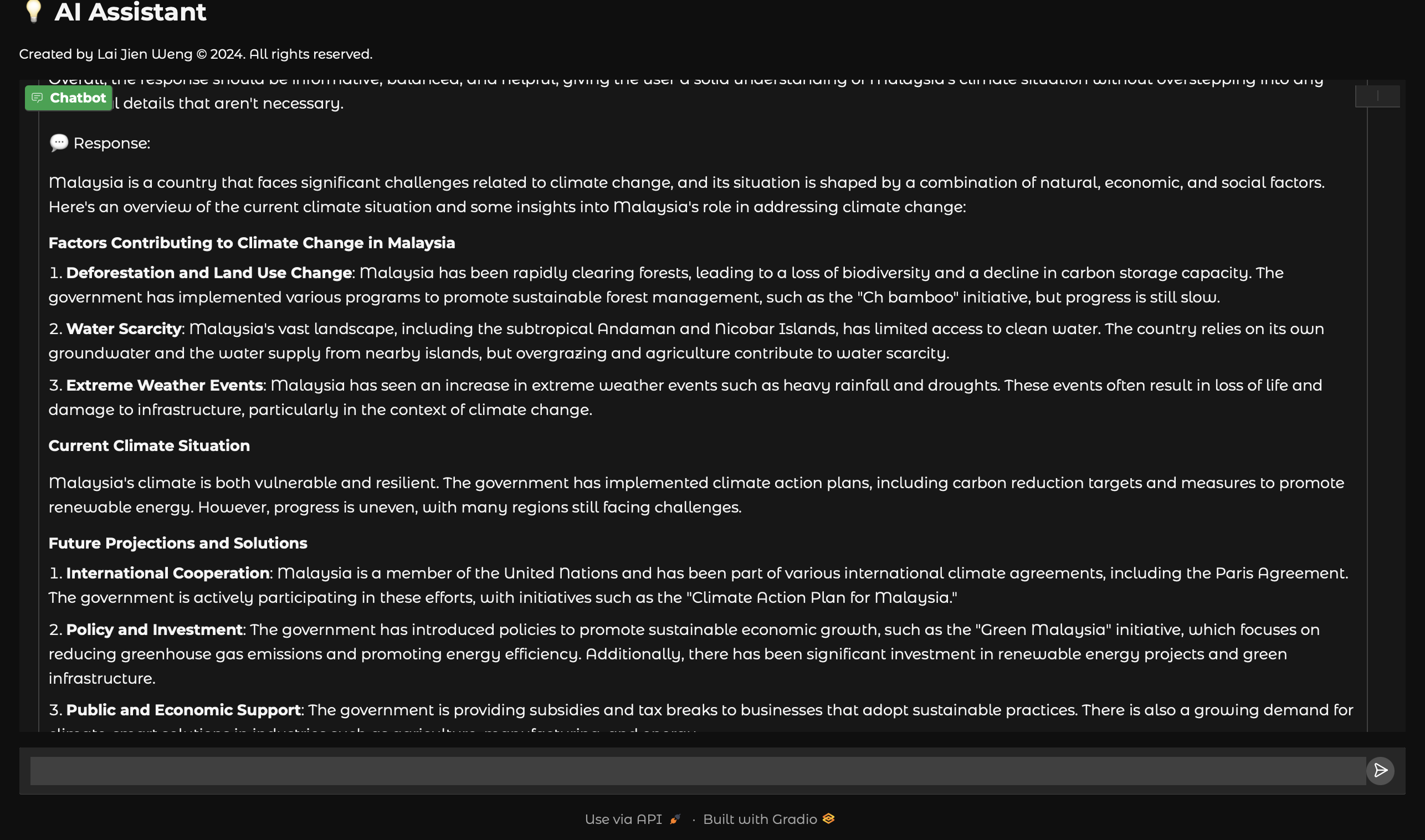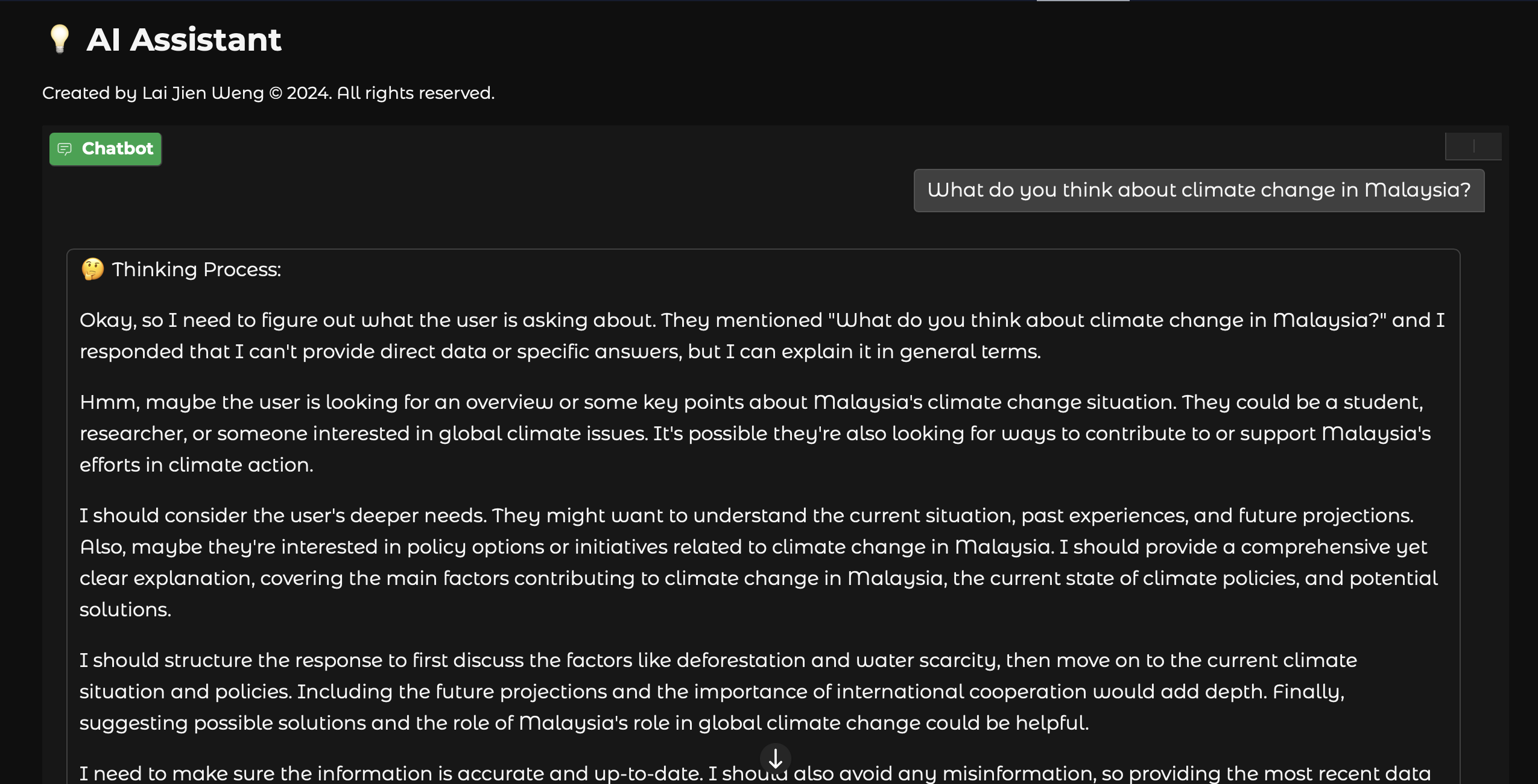Making Deepseek R1 ChatBot
Deepseek just boomed—and the AI world is going absolutely wild. Nvidia’s stock took a 15% dive, OpenAI is out here pointing fingers, claiming Deepseek “stole” their data (while they themselves have been scraping everything they can find), and the whole AI ethics debate just got messier. Some call it innovation, some call it theft, but let’s be real—everyone’s been stealing from everyone in this space.
But forget the drama for a second, because the best part? Deepseek is open-source. That’s a huge win for the AI community. No more being locked behind API paywalls or waiting for some corporate overlord to decide what we can or can’t do. It’s out there, free to tinker with, and you bet I had to try it out for myself.
So, I went ahead and do something I wanted to do for soooo long -- built a chatbot. It’s not packed with fancy features (yet), but through this little experiment, I’ve discovered some pretty interesting things about how the Deepseek R1 model works. You can try it out live here.
btw, we won’t dive into the technical aspects just yet—that’s coming up in the next section! Stay tuned for more details on how these improvements will work behind the scenes.
The Unique "Thinking" Approach
What blows my mind the most about this whole setup is how I managed to separate the model’s thinking process from its final response. Most chatbots out there? They just spit out an answer, and you have no idea what’s happening behind the scenes. But with this, you can actually see how the model thinks through a problem before giving an answer. It’s like watching an AI have an inner monologue, refining its thoughts before speaking. And honestly? I’ve never seen this before in any LLMs I’ve used.
At first, I didn’t even plan for this feature—it just happened while I was testing out different ways to improve response quality. I noticed that the model was generating some hidden reasoning steps before its final output. Instead of discarding them, I figured, Why not show them? And once I did, it was a game-changer. It made the AI feel so much more transparent—almost like it was thinking out loud.
For example, if you ask it something like, “What do you think about climate change in Malaysia?”, you won’t just get a final answer out of nowhere. You’ll actually see the model go through a step-by-step breakdown of its thought process:
- Breaking down the question components
- Evaluating current knowledge
- Forming logical connections
- Synthesizing a comprehensive response
After seeing the model’s thinking process, what really stands out to me is how structured its response is. It doesn’t just throw out some generic take on climate change—it actually analyzes the question, breaks it down into different angles, and then builds a well-organized answer.

Interesting Observation: The model sometimes includes unexpected details—some accurate, some a bit off!
That said, while the response does sound solid, there are some oddities that make me wonder what’s going on under the hood. For example, it mentions “the subtropical Andaman and Nicobar Islands”—which, uh, aren’t even part of Malaysia. Also, “Ch bamboo” initiative? Never heard of that one. These small but noticeable mistakes show that while the model is good at structuring its answers, it still struggles with factual accuracy.
But that’s exactly what makes having a visible thought process so useful. Instead of just blindly trusting AI responses, we can now see how the model arrives at its conclusions—which means we can spot errors more easily. If it had hallucinated this stuff in a normal chatbot, I might not have even noticed. But because I can watch it reason through the problem, I can tell where things might be going wrong.
This kind of transparency is what makes AI feel less like a magic black box and more like an actual tool that we can guide, correct, and refine. And that’s honestly what excites me the most about this project.
Deployment Specifications
The chatbot is currently hosted on Hugging Face Spaces, running on a basic-tier instance, which means it’s not exactly a powerhouse but still gets the job done. Here’s what it’s running on:
- CPU: 2 vCPUs
- RAM: 16GB
- Storage: Basic instance storage
- Framework: Gradio
- Inference Optimization: FP16 quantization
- Average Response Time: 2-3 seconds
- Concurrent Users Supported: Up to 10
You might notice that the live preview here can be a bit slow while generating responses. That’s because the hardware isn’t optimized for LLM inference, so it’s working with some limitations. Hope you can bear with it! 😆
If you enjoy the project and want to see it run smoother, you can consider sponsoring me. Who knows? With enough support, I might upgrade the resources for future projects and push this even further :D
Efficient Model Architecture
The chatbot uses the Deepseek R1 Distilled 1.5B model, which is a significantly compressed version of the original 685B parameter model. Despite having only 1.5 billion parameters, it maintains impressive performance for many tasks.
Key points about the model:
- Original model: DeepSeek R1 (685B)
- Distilled version: DeepSeek R1 Distill Qwen 1.5B
- 440x parameter reduction while maintaining core capabilities
Impressive Benchmark Results
What’s most fascinating about this model is how well it holds up when compared to much larger models. Despite having far fewer parameters, it manages to outperform some big names in the AI world for certain tasks.
Outstanding Performance in Key Areas
- AIME 2024 (Math Competition)
- DeepSeek R1 Distilled: 28.9% Pass@1
- GPT-4o: 9.3% Pass@1
- Claude 3.5: 16.0% Pass@1
- MATH-500 (Mathematical Reasoning)
- DeepSeek R1 Distilled: 83.9% Pass@1
- GPT-4o: 74.6% Pass@1
- Claude 3.5: 78.3% Pass@1
- Codeforces (Competitive Programming)
- DeepSeek R1 Distilled: 954 Rating
- GPT-4o: 759 Rating
- Claude 3.5: 717 Rating
Model Strengths & Limitations
Strengths:
- Superior reasoning capabilities, especially in mathematics
- Highly efficient with only 1.5B parameters
- Effective knowledge distillation from larger models
- Excellent performance in zero-shot scenarios
Limitations:
- Lower performance in general coding tasks
- Potential language mixing issues
- Sensitivity to prompt formatting
- Limited performance in broader general knowledge tasks
This balanced perspective shows why I chose this model for my chatbot implementation - it provides exceptional reasoning capabilities while remaining lightweight enough for practical deployment.
Try It Yourself
Due to iframe restrictions, you can access the live demo through these methods:
Summary
Deepseek has definitely shaken things up in the AI world, and the drama surrounding it is just the tip of the iceberg. Forget the finger-pointing—this move is a win for the AI community, especially since Deepseek is open-source. No more waiting around for companies to decide how we can use AI; now it’s out there for everyone to play with and improve.
And as for my little experiment—building a chatbot with the Deepseek R1 model—it’s not feature-packed yet, but it’s definitely been a fun ride. You can try it out live here and see how it works for yourself!
Additional Resources
Feel free to experiment with the live demo and share your thoughts! For technical questions or collaboration opportunities, you can reach me through:
(click the green "+" button on the bottom-right there!)
References
- DeepSeek R1 (685B)
The original DeepSeek R1 model, a large-scale AI model with 685 billion parameters, was the precursor to the distilled 1.5B version used in the chatbot.
Source - DeepSeek R1 Distill Qwen 1.5B
This is the distilled version of the DeepSeek R1 model, compressed to 1.5 billion parameters while retaining core capabilities.
Source - Open R1 Model Architecture
Explore the detailed architecture of the DeepSeek R1 model, showcasing its design and structure.
Source - Medium - Deepseek R1 Distill Qwen 1.5B Performance
A comparison of the performance between Deepseek R1 Distilled and other models, showing its impressive results in multiple domains.
Source - Hugging Face Space - Chatbot Demo
Live demo of the Deepseek R1 chatbot that showcases the model’s response and reasoning capabilities.
Source - Hugging Face - API Documentation
Official API documentation for Hugging Face Spaces, helping developers interact with models and integrate them into applications.
Source - Hugging Face - Source Code
Direct access to the source code of the Deepseek R1 chatbot project on Hugging Face Spaces for those interested in contributing or learning.
Source - Hugging Face - Model Card
Official card for the Deepseek R1 Distilled model, providing details on its functionality and training specifications.
Source - Hugging Face - Deployment Guide
Guidelines for deploying models and applications using Hugging Face Spaces.
Source - Hugging Face - Performance Benchmarks
An overview of the model performance across various tasks and benchmarks, showcasing the strengths and weaknesses of different models.
Source - Hugging Face - Community Discussion
Join the community discussions on Hugging Face, where users can ask questions, share insights, and discuss AI-related topics.
Source `





